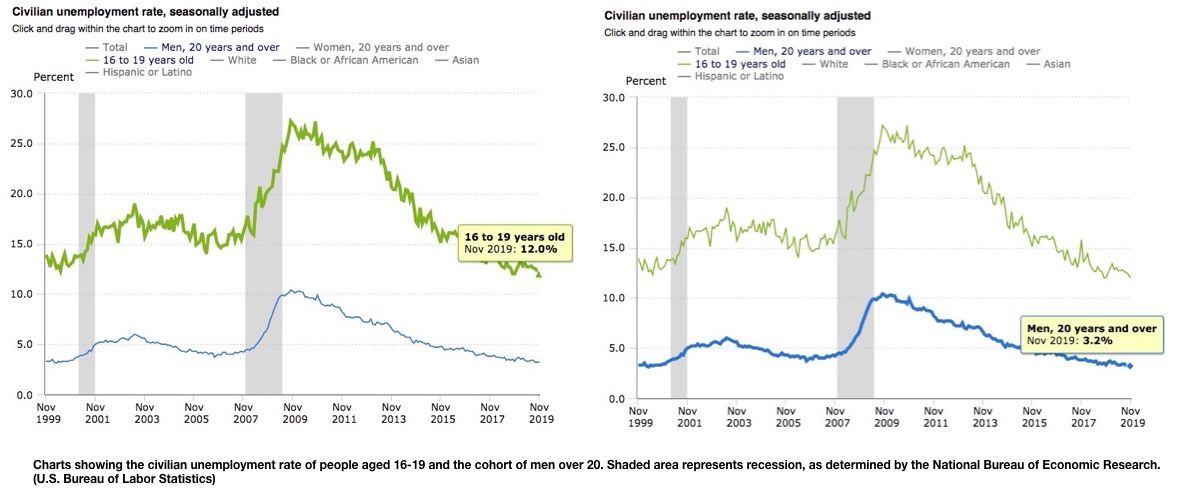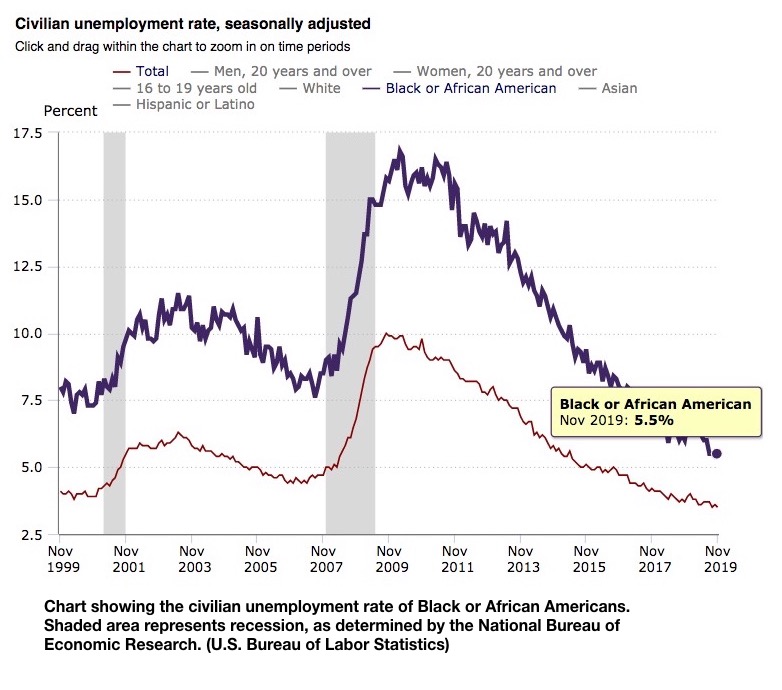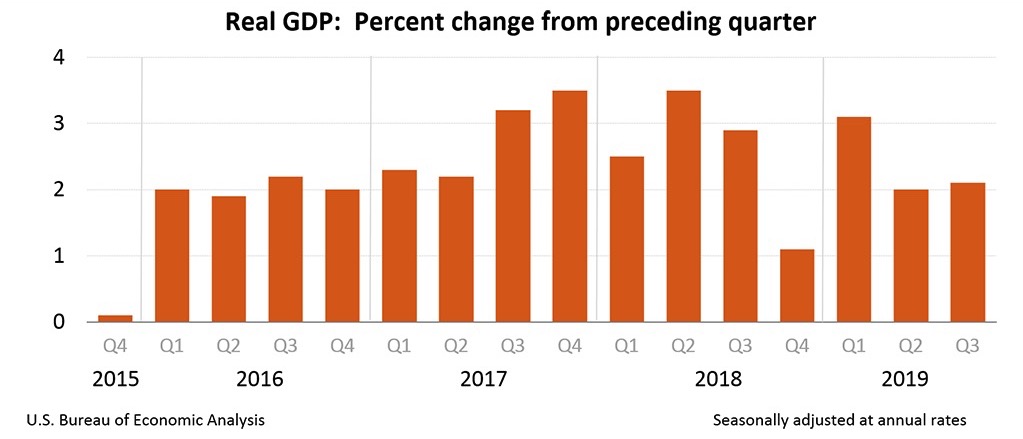BY
The economy is finishing the year in stronger shape, thanks in part to resilient consumers and a healthy job market.
With near-record low unemployment and solid wage growth, the U.S. labor market is expected to continue to underpin consumer spending and the economy.
The Commerce Department said Friday that the total output of goods and services, or the gross domestic product (GDP), expanded at an annual rate of 2.1 percent in the July-September quarter.
“The economy is still solid,” said Diane Swonk, chief economist at Grant Thornton. “What this economy has lacked in momentum, it has made up for in stamina, and the Fed gave it a shot of adrenaline this year with three rate cuts.”
The Federal Open Market Committee, which determines interest rates, said after its most recent meeting on Dec. 11 that a healthy labor market contributed to its decision to keep the federal funds rate unchanged, within a target range of 1-1/2 to 1-3/4 percent.
“The labor market remains strong and that economic activity has been rising at a moderate rate,” the Committee said. “Job gains have been solid, on average, in recent months, and the unemployment rate has remained low.”
The Federal Reserve is conducting a review of its monetary policy tools, due for completion next year.
“First, as this expansion continues into its 11th year—the longest in U.S. history—economic conditions are generally good,” said Fed Chair Jerome Powell in November. “Second, the benefits of the long expansion are only now reaching many communities, and there is plenty of room to build on the impressive gains achieved so far.”
“Recent years’ data paint a hopeful picture of more people in their prime years in the workforce and wages rising for low and middle-income workers,” Powell added.
Employment Figures
The latest employment figures, released on Dec. 6, show that nonfarm payroll employment rose by 266,000 in November, and the unemployment rate stood at 3.5 percent.
“Notable job gains occurred in health care and in professional and technical services,” said William W. Beach, Commissioner of the Bureau of Labor Statistics.
Unemployment rates were lower in November in 7 states, higher in 5 states, and stable in 38 states and the District of Columbia, the U.S. Bureau of Labor Statistics reported on Dec. 20. Seven states had jobless rate decreases from a year earlier, two states had increases, and 41 states and the District had little or no change.
Figures show that in January 2019, the unemployment rate among men 20 years old and over was 3.7 percent, while the jobless rate for women in the same age bracket was 3.6 percent. In November, the unemployment rate for both combined fell to 3.2 percent.
By comparison, joblessness among the cohort of 16 to 19-year-olds was down to 12 percent in November, compared to 12.9 percent in January. Peak unemployment for this group in the past two decades hit 27.2 percent in October 2009.
Joblessness among Black or African Americans reached historic lows in 2019, falling from 6.8 percent in January to 5.5 percent in November.
Strong Consumer Spending
A Labor Department report showed that consumer spending grew by a solid 0.4 percent rate in November, the strongest gain since July, and that incomes rebounded after a weak reading in October.
Personal income increased $101.7 billion (0.5 percent) and disposable personal income (DPI) increased $87.7 billion (0.5 percent) in November, according to estimates released on Dec. 20 by the Bureau of Economic Analysis.
The brisk pace of spending in November is a reassuring sign that consumers, who account for about 70 percent of economic activity, are helping buoy the economy amid international trade tensions.
Many economists are forecasting that the economy is expanding at a respectable 2 percent annual rate in the final quarter of the year.
Unemployment Claims Drop
The number of Americans filing applications for unemployment benefits dropped last week by 18,000 to a seasonally adjusted 234,000 for the week ended Dec. 14, the Labor Department said.
The surge in the week ended Dec. 7, which boosted claims to 252,000—the highest reading since September 2017—probably reflected a late Thanksgiving Day this year compared to 2018. That could have thrown off the model used by the government to strip out seasonal fluctuations from the data.
“At this point we are not concerned about the rise in initial claims and view it as a statistical quirk related to the seasonal adjustment process around Thanksgiving,” said John Ryding, chief economist at RDQ Economics in New York.
Employment Projections
The U.S. Bureau of Labor Statistics (BLS) expects employment to grow by 8.4 million jobs to 169.4 million jobs over the 2018-2028 decade.
The sectors projected to experience the fastest annual employment growth are health care and social assistance (1.6 percent), private educational services (1.2 percent), and construction (1.1 percent), the BLS said in a September press release. The agency estimated that these three sectors alone will add more than 4.6 million jobs by 2028.
The BLS said five sectors are projected to experience employment declines from 2018 to 2028: retail trade, wholesale trade, utilities, federal government, and manufacturing
The agency estimates that retail trade will decline by 0.1 percent per year, driven in part by a shift to e-commerce. The trend is projected to cause 153,700 retail jobs to disappear.
Workers aged 65 years and older are increasingly staying in the workforce, the BLS said. “The labor force participation rate for these workers is expected to increase to 23.3 percent by 2028,” the agency noted.
The trend is much the same for workers ages 55 and older, a group that includes baby boomers. The labor participation rate for this cohort is projected to continue to increase over the 2018–2028 decade, from 23.1 percent to 25.2 percent, the BLS said.
The agency said that it expects real GDP to grow at 1.8 percent from 2018 to 2028, much the same rate as it did in the previous decade.
Labor productivity is expected to accelerate slightly from the previous decade to an annual rate of 1.6 percent. Growth in productivity in the previous decade stood at 1.3 percent per annum.
The BLS expects the overall labor force to grow at an annual rate of 0.5 percent from 2018 to 2028, which represents an increase of 8.9 million over the decade to 171 million by 2028. At the same time, the labor force participation rate is projected to decline to 61.2 percent, driven mostly by a decrease in the participation rate for men, from 69.1 percent to 66.1 percent.
Reuters and Associated Press contributed to this report.
Republished with Permission The Epoch Times SUBSCRIBE
Get Citizensjournal.us Headlines free SUBSCRIPTION. Keep us publishing – DONATE







